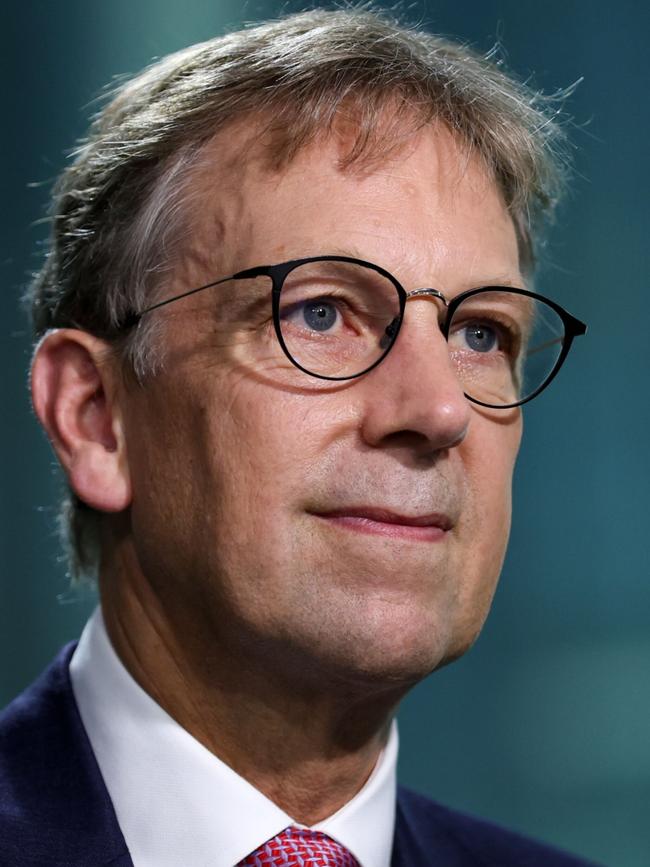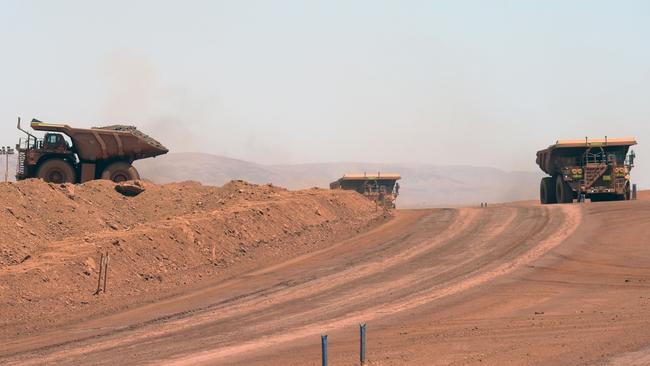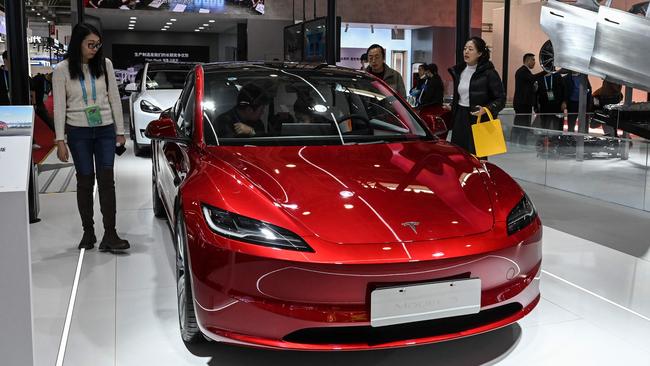Iron and copper: Rio boss finds his inner miner
On the three-year anniversary of Jakob Stausholm’s appointment, a repurposed Rio Tinto is starting to take shape.
Business
Don't miss out on the headlines from Business. Followed categories will be added to My News.
The past 12 months were always going to be a test for Jakob Stausholm, the ever-optimistic Rio Tinto boss, and his ambition to fundamentally repurpose the 150-year-old miner.
The hard measure of Stausholm’s efforts would only ever be realised on the ground at Rio’s hard-rock mining operations, spanning iron ore to copper. That change is coming from a chief executive whose background has been grounded in oil and global shipping.
For the big volume-driven miners, investors reward predictability while punish the negative shocks. From the view of a mining boss, commodity prices will always be volatile, and this means consistency and costs are among the few things that mining bosses can control.
After taking charge in the wake of Rio’s Juukan Gorge cave crisis, Stausholm immediately promised two big themes to his Rio leadership.

He wanted Rio to have “impeccable” environment, social and governance credentials as it become a more outward-looking company. And in the commodities it mined, Rio had to be the best operator.
On the three-year anniversary of Stausholm’s appointment, there are signs of steady improvements in Rio’s operational performance. And this reversal of form follows years of regular slippage and misses. Rio’s two big engines, iron ore and copper, are firing together while costs – for now – have been relatively contained in the face of a global inflation breakout.
The outcome has come about while Stausholm has plenty going on. He has an ever-ambitious green energy agenda, while he is edging to full-blown commitment to Rio’s share of the $US22bn ($33.2bn)-plus Simandou iron ore project in Guinea. The project including rail and port infrastructure represents one of the biggest hard rock mining projects in the world today. Rio’s share is earmarked at $US6.2bn in coming years.
With the ramp-up of the new and mostly-automated Gudai-Darri Pilbara mine replacing maturing mines, Rio has delivered some of its best full year iron ore numbers in six years. Full-year iron ore shipments of 331.8 million tonnes came in 3 per cent ahead of a year earlier, its December quarter update shows. But this time output comfortably hit the top end of Rio’s own guidance, where in each of the past three years has only just made past the bottom of the company’s own internal forecasts. Rio doesn’t want to push too hard but has slightly increased its internal targets for the coming year, targeting a record 338 million tonnes at the top end, up from 335 million tonnes last year.

Rio puts the improved performance into spending more on capital and maintenance, helping to deliver consistency of big trucks, diggers and trains as well as scheduling. And on the ground, it has been steadily rolling out the Safe Production operating system across iron ore that empowers front line workers to make decisions around productivity gains as well as safety. Incremental improvements all adds up, with the Safe Production System so far delivering an annualised 5 million tonnes increase in iron ore production. The operating system is in the process of being rolled out across all Rio’s sites.
Copper too represents another brighter spot for Rio into 2024, just as prices are stabilising as the global economy looks to emerge from the worst of interest rate hikes.
The addition of new copper output from new underground operations at Rio’s vast Oyu Tolgoi mine in Mongolia saw copper production jump 26 per cent, helped too by higher grades.
A massive rebuild of Rio’s Kennecott copper smelter in Utah and repairs to a processor that failed at the start of the year will see copper output steadily increase into the coming year. Rio is targeting between 660,000 and 720,000 tonnes of copper output this year. This would represent a record year near the top and is up from 620,000 in 2023.
With a reset of relations under Stausholm there are still bumps in the road between Rio Tinto and the Mongolian government with the mine being slapped with an additional $US80m tax bill relating to an audit over 2019 and 2020 arriving shortly before Christmas. Rio said it will continue to make all payments required under Mongolian legislation and the mine’s investment agreement. Rio holds a 66 per cent stake in Oyu Tolgoi with the remaining 34 per cent owned by the Mongolian government. In other areas, there were production gains in bauxite, aluminium and titanium.
With production in check, iron ore and copper costs will come under focus when Rio releases its full-year results on February 21, with the miner warning labour costs are still rising given tight markets in Australia, Canada and the US. Another year of consistent performance will go a long way to solidifying Stausholm’s mining credentials.
Keeping EV faith
Lithium remains a point of difference between Rio and BHP, with the latter opting to sit out of the race for the battery mineral for now. BHP’s stand is looking better than this time last year, with lithium carbonate spot prices slumping 80 per cent since March.
The losses have come about amid a reassessment over the outlook for demand for electric vehicles which has been driving sentiment for lithium. A key moment came about in recent days when car rental giant Hertz said it was selling about a third of its EV fleet, citing higher costs and limited demand. More broadly, EV demand has slowed around the world, with the early adopter market seen as full and demand tapering off from main street buyers.
Rio, which is building a lithium processing plant in Argentina for its Rincon project remains bullish over the long-term market fundamentals for lithium.

It says EV penetration rates will continue to increase. “More investment into mine supply will be required to fill the supply gap,” the miner says.
Meanwhile, Rio has suggested China could be past the worst of its slowdown, even as the troubled property market there continues to hammer confidence. China is poised for a gradual recovery through 2024, helped by government stimulus measures, with the bulk of the recovery weighted towards the second half. This should hold up iron ore demand. Economists expect China’s economic growth to come in at 4.6 per cent in the coming year. This would represent a slowdown from the expected 5.2 per cent growth this year. Official GDP figures are scheduled for release on Wednesday.
So long Sezzle
Sezzle, the buy now, pay later junior that was involved in a failed $500m merger deal with bigger rival Zip Co, has finally left the boards of the ASX.
At its peak, Sezzle had a lofty market capitalisation of nearly $900m, but those days are long behind it. The exit has come about as Sezzle switches to a Nasdaq listing, aligning itself to the US market where the bulk of its operations are based.

In its ambition to get on the Nasdaq boards, Sezzle in recent months undertook a complex stock consolidation by a factor of 38 to one. This had the effect of dramatically pumping up the face value of its shares, although not the overall worth of the company. On its exit, Sezzle was trading with a market capitalisation of $46.8m, a steep discount to the $US67m ($101m) in cash it still has sitting in the bank at the end of the third quarter.
After the Covid party buy now, pay later players have suffered a long hangover. This was brought about by the triple-whammy of surging funding costs, rising lending losses and a slow-down in consumer spending. Amid the fallout, Sezzle’s agreed merger deal was later blocked by Zip’s board in mid-2022.
Later that year sector darling Afterpay was acquired by Jack Dorsey’s fintech Block an all stock deal worth $US29bn at the time. Afterpay is still being digested by Block’s shareholders, although the Dorsey run fintech has seen a turn in fortunes in recent months and today is worth more than US$40bn.
johnstone@theaustralian.com.au
More Coverage
Originally published as Iron and copper: Rio boss finds his inner miner




